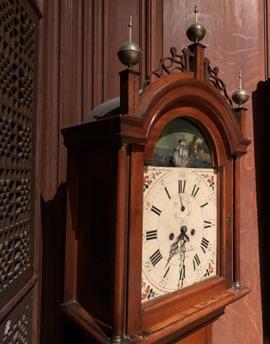Hannah Goeselt,图书馆助理
In my last blog post I introduced one of the grandfather clocks (‘钟007’) held here at the MHS, as well as its clockmaker, Joshua Wilder. In this next post we will explore some of the other craftspeople that contributed to the creation of this piece.

The process that goes into creating the finished piece is complex and involves many distinct types of artisans, of which the 实习生al brass movements is only one contributing piece. The base components themselves involved purchasing brass casts from a local foundry, 以及从波士顿进口的铁皮表盘. 外壳也是如此, 铁的重量, 装饰绘画, 保护玻璃, and crowning metal finials must be outsourced and brought together to create the final clock, either by the clock movement manufacturer or as was sometimes the case by the cabinetmaker.
The wood casing that houses the clock movements is one of the more visible qualities in the final product. This particular one was attributed to Abiel White (1766-1844), 来自韦茅斯的橱柜匠, during the clock’s conservation and restoration in 2011-13. 怀特是怀尔德的长期合作者, though he also worked with other clockmakers in the region in housing their brass clock movements in mahogany or pine. 归功于他或他的工作室, 未签名时, are often based on construction techniques that are peculiar to him, such as using textured paper to seal together board-seams, double “dovetail” notches to attach the hood to the case, and a construction technique that uses numbered pieces fit together in a clockwise pattern. 当前从视图中隐藏, these qualities were uncovered during its conservation and were very helpful in identifying White’s work.
To me, the most eye-catching feature is the mechanism set directly above the clockface. 在这里, 半圆形的海景画, 或半月形, depicts a coastline with an old stone building situated on a grassy outcrop and what may be a small burying ground with three gravestones. Set in front of the scenery is an articulated three-masted frigate that teeters gently to and fro with the ticking of the seconds, an upper extension of the clock’s pendulum hidden behind the door of the case. The vessel waves a 13-star Cowpens variant of the US flag from its stern, and from its main topmast flies the first Naval Jack (the “don’t tread on me” rattlesnake, 一个不合时宜的添加, 缺席). These details seem to indicate that the moving dial is meant to represent a ship from the Continental Navy, though the exact design of both flags have contested histories of their actual use in the Revolutionary War. 而, this is a 19th century vision of national origin-building, made more within the historical context of the War of 1812.

可能是从波士顿的工匠那里进口的, the rocking ship dial is seen in multiple other examples from this period and region, with its popularity beat only by a painted disk that rotates through the phases of the moon. A brief look into the Boston ornamental painting business in the 1790s through the first three decades of the 19th century shows a small collection of highly specialist artisans who worked closely with and depended heavily on commissions from the much larger furniture and clock making industries. 虽然大部分作品仍未署名, some individuals may be identified based on the clockmakers they were known to work regularly with. Names of Boston decorative artists such as John Ritto Penniman, 约翰Minott, Samuel Curtis and Spencer Nolen are some of the more researched today, but certainly not the extent of the community in the period.
至于出处, there is no official recording of when and from where the Society acquired this clock, 除了旧的国安局藏物编号, 0979. Most of the MHS’s clocks were donated in the 1960s and ‘70s, with a couple coming to us in the early 1920s; the earliest recorded purchased from the manufacturer directly in 1857. Checking the piece itself for information proved equally fruitless. Other than a small clipping that outlines Wilder’s biography, no interior markings offer clues to its journey here. 如果我们幸运的话, the presence of ephemeral bills of sale or a creator’s name inscription would provide hints as to its past.

If you are interested in learning more on the inter-related industries at work in creating clocks in New England, 一个很好的起点是Paul J. Foley’s “Biographies of Patent Timepiece Makers, 装饰性的画家, 家具, 和联合工匠”页.207-339,在他的专著中 威拉德的专利钟表 (2002).
龙头:
约翰,布洛克,加里·R. 沙利文和杰克·奥布莱恩. 港 & Home: Furniture of Southeastern Massachusetts, 1710-1850, 新英格兰大学出版社,2009年. (超大NK2435.M34 J55 2009)
布鲁斯·福尔曼. 《利记手机官网》. The Decorator: Journal of the Historical Society of Early American Decoration 50 no. 1(1995-96秋冬):7-24. 1995年秋季.pdf (hsead.org)
保罗·J·福利. 《利记APP官网手机版》中 威拉德的专利钟表: A History of the Weight-Driven Banjo Clock, 1800-1900, 诺威尔,麻萨诸塞州:罗克斯伯里村出版社,2002年. 178-183. (NK7500.B35 F65 2002)

